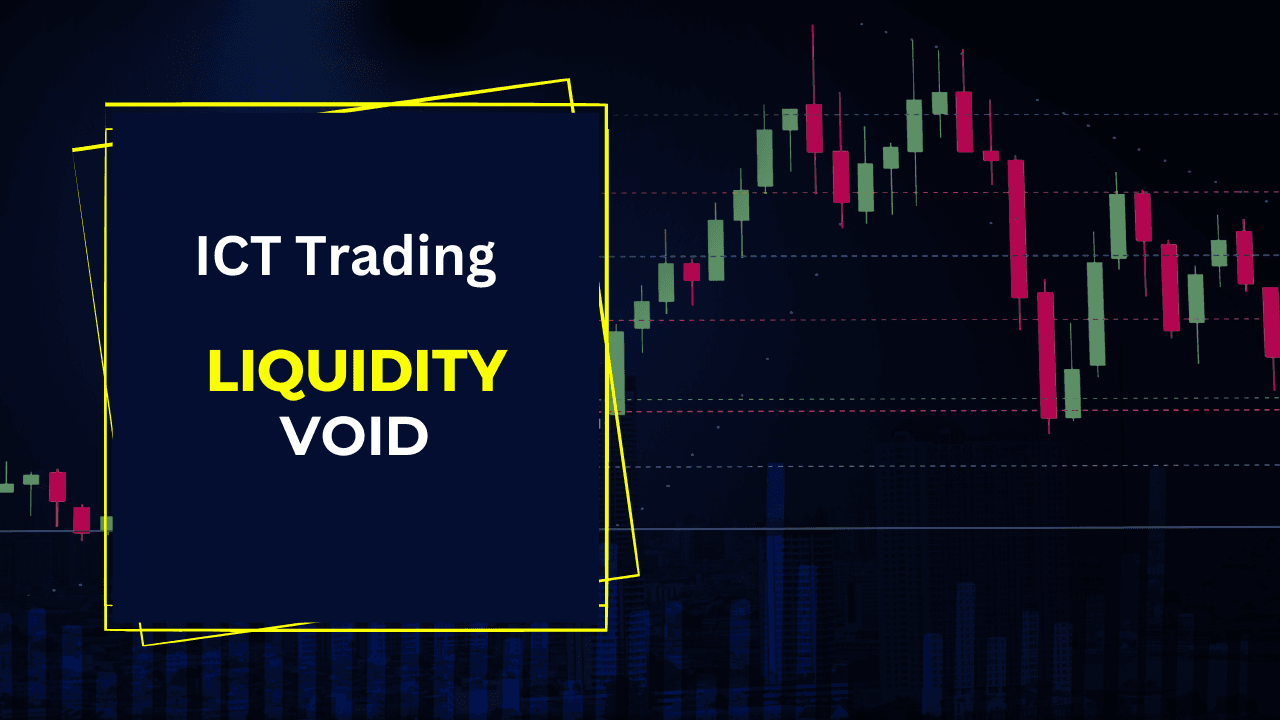In the dynamic world of trading, understanding market behavior is crucial for success. One critical concept that every trader should grasp is the liquidity void. A liquidity void refers to a significant gap in the market where trading volume is substantially reduced, often leading to unpredictable price movements. In the context of Inner Circle Trading (ICT), recognizing and leveraging liquidity voids can provide traders with valuable insights into potential market shifts and opportunities. This article delves into the intricacies of liquidity voids, exploring their characteristics, importance, and how traders can effectively use this knowledge to enhance their trading strategies. By mastering the concept of liquidity void, traders can navigate the markets with greater confidence and precision.
What is a Liquidity Void?
A liquidity void is a term used to describe an area in the market where there is a notable lack of liquidity, leading to fewer buy and sell orders. In simpler terms, it represents a gap where trading volume is significantly lower than average. These gaps can occur for various reasons, including major news events, sudden market shifts, or changes in trader sentiment.
Characteristics of Liquidity Void
- Lack of Orders: In a liquidity void, there are fewer buy and sell orders available at certain price levels. This lack of orders means that if a trader tries to execute a trade, they may experience slippage, resulting in a price different from what they expected.
- Price Movement: When a market encounters a liquidity void, prices can move rapidly and unpredictably. This is because there are not enough orders to absorb the market’s activity, leading to sharp price swings.
- Market Structure: Liquidity voids often occur around significant support and resistance levels. When price approaches these areas, the presence of a liquidity void can lead to breakouts or reversals, creating potential trading opportunities.
Understanding liquidity voids is essential for traders because it helps them identify where significant price movements may occur. By recognizing these gaps, traders can make informed decisions about entry and exit points, ultimately enhancing their trading strategies.
Why Liquidity Void Matters in ICT
In the context of Inner Circle Trading (ICT), recognizing and understanding liquidity voids is vital for several reasons. The presence of a liquidity void can significantly impact market dynamics and trader decision-making.
Market Dynamics
- Impact on Price Action: Liquidity voids can create opportunities for traders to capitalize on price movements. When price enters a liquidity void, it may accelerate quickly, allowing traders to capture profits if they anticipate the movement correctly.
- Volatility: Areas with liquidity voids often experience increased volatility. Traders should be aware of these areas as they can lead to rapid price changes that may not align with overall market trends. Understanding this volatility is essential for effective risk management.
Risk Management
- Mitigating Risks: By identifying liquidity voids, traders can better manage their risks. For example, placing stop-loss orders just outside these voids can help protect against adverse price movements.
- Informed Decisions: Understanding liquidity voids allows traders to make more informed decisions when entering or exiting trades. For instance, if a trader knows that a liquidity void exists at a certain price level, they may choose to wait for a more favorable entry point to avoid unnecessary risk.
In summary, liquidity voids play a crucial role in Inner Circle Trading by influencing market dynamics and providing insights into potential price movements. Recognizing these gaps can enhance a trader’s ability to navigate the market effectively and improve overall trading performance.
How to Identify Liquidity Voids
Identifying liquidity voids is essential for traders looking to capitalize on price movements in the market. Understanding where these gaps exist can help traders make informed decisions regarding their entry and exit points. Here are some effective methods to identify liquidity voids:
Technical Analysis Tools
- Volume Analysis: Analyzing trading volume is one of the most effective ways to spot liquidity voids. When there is a significant drop in trading volume at a certain price level, it indicates a potential liquidity void. Traders should look for areas on the chart where volume spikes are absent, especially during price moves.
- Candlestick Patterns: Certain candlestick patterns can signify liquidity voids. For instance, large bullish or bearish candles that move away from previous price levels with minimal pullbacks often indicate a liquidity void. Look for these patterns to identify areas where price could experience rapid movements.
- Support and Resistance Levels: Liquidity voids often occur near support and resistance levels. By plotting these levels on a chart, traders can observe where price action is likely to encounter reduced liquidity. These levels can serve as reference points for identifying potential voids.
Practical Examples
To further illustrate how to identify liquidity voids, consider the following example:
- Case Study: Imagine a stock that has been trading steadily within a specific range. Suddenly, a news announcement causes a large price jump with minimal trading volume. As the price moves away from this level, you may notice that the volume is significantly lower than usual. This scenario highlights a liquidity void, indicating potential price volatility if the stock revisits this level.
How to Use Liquidity Void in Trading
Once traders have identified liquidity voids, the next step is to effectively use this knowledge in their trading strategies. Here are several ways to integrate liquidity voids into your trading plan:
Trading Strategies
- Entry and Exit Points: Liquidity voids can provide excellent entry and exit points for trades. For example, if a trader identifies a liquidity void above the current price level, they might consider entering a buy position as the price approaches this void, anticipating that it will fill quickly.
- Breakouts: When price approaches a liquidity void, it can lead to significant breakouts. Traders should look for confirmation signals, such as increased volume or specific candlestick patterns, to enter a position when the price breaks through the void.
- Reversal Trades: In some cases, liquidity voids can indicate potential reversals. If a trader observes that price has moved into a liquidity void and begins to show signs of exhaustion, they might consider placing a sell order to capitalize on the expected reversal.
Trade Management
- Adjusting Stop-Loss Orders: When trading around liquidity voids, adjusting stop-loss orders is crucial for risk management. Traders should place stop-loss orders just outside the liquidity void to protect against unexpected price movements. This helps limit losses while allowing for potential profits if the trade moves in the desired direction.
- Timing the Trade: Timing is essential when using liquidity voids. Traders should be patient and wait for the right moment to enter or exit a trade. Observing price action and volume can provide valuable insights into the best timing for executing trades around liquidity voids.
In summary, effectively utilizing liquidity voids in trading can enhance a trader’s strategy and improve overall performance. By identifying these gaps and employing sound trading techniques, traders can navigate the market with increased confidence and make informed decisions.
Common Mistakes to Avoid
Understanding liquidity voids is crucial for traders, but even seasoned traders can make mistakes when navigating these gaps. Here are some common pitfalls to avoid:
Misinterpretation of Liquidity Voids
- Assuming All Gaps Are the Same: Not all liquidity voids are created equal. Traders often mistakenly assume that all gaps will behave similarly, leading to overconfidence in their trades. It’s important to assess each liquidity void based on its context, volume, and surrounding price action to understand its significance accurately.
- Ignoring Market Context: Liquidity voids must be viewed in the context of overall market trends and news events. For instance, if significant news is driving price movements, liquidity voids may behave differently than during a quiet market phase. Failing to consider the broader market context can lead to misguided trades.
Overtrading Risks
- Chasing Price Moves: One of the biggest mistakes traders make is chasing price movements in liquidity voids without proper analysis. This can lead to impulsive trading decisions that result in losses. It’s essential to wait for confirmation signals, such as volume spikes or reversal patterns, before entering trades.
- Neglecting Risk Management: Many traders focus solely on potential profits when trading around liquidity voids, neglecting their risk management strategies. This oversight can lead to significant losses, especially in volatile markets. Traders should always have a clear risk management plan, including setting appropriate stop-loss levels.
By being aware of these common mistakes, traders can refine their approach to liquidity voids, making more informed decisions that enhance their trading success.
Conclusion
In conclusion, understanding liquidity voids is a fundamental aspect of successful trading in the context of Inner Circle Trading (ICT). These gaps in the market can provide valuable insights into potential price movements, helping traders to identify key entry and exit points. By employing effective techniques to identify and utilize liquidity voids, traders can enhance their strategies and improve their overall trading performance.
However, it is equally important to be aware of the common mistakes that can occur when trading around liquidity voids. Misinterpreting these gaps, overtrading, and neglecting risk management can lead to unnecessary losses. By following the guidelines outlined in this article and maintaining a disciplined approach, traders can navigate the complexities of liquidity voids with greater confidence.
Mastering the concept of liquidity voids not only improves trading strategies but also empowers traders to make informed decisions in an ever-changing market environment. As traders continue to learn and adapt, their understanding of liquidity voids will serve as a valuable tool in their trading arsenal.
Read More SMT in Trading- A Quick Guide
Frequently Asked Questions
What is a liquidity void?
A liquidity void refers to an area in the market where there is a significant lack of trading volume, leading to gaps in price movement. This can occur when there are few buy or sell orders at certain price levels, causing prices to move rapidly without sufficient liquidity to absorb the trades.
How do I identify liquidity voids?
To identify liquidity voids, traders can use various techniques, including:
- Volume Analysis: Look for areas on the chart with a significant drop in volume, indicating lower trading activity.
- Candlestick Patterns: Monitor for large candles with minimal pullbacks, which may signal the presence of a liquidity void.
- Support and Resistance Levels: Analyze key support and resistance levels where liquidity voids often occur.
Why are liquidity voids important in trading?
Liquidity voids are important because they can lead to rapid price movements and volatility. By understanding where these voids exist, traders can make informed decisions about entry and exit points, ultimately enhancing their trading strategies and risk management.
How can I use liquidity voids in my trading strategy?
Traders can use liquidity voids in several ways:
- Identifying Entry and Exit Points: Use liquidity voids to determine potential buy or sell areas.
- Spotting Breakouts: Look for confirmation signals when price approaches a liquidity void to capitalize on breakouts.
- Risk Management: Adjust stop-loss orders just outside liquidity voids to protect against adverse price movements.
What are common mistakes to avoid when trading around liquidity voids?
Common mistakes include:
- Misinterpreting liquidity voids: Not all gaps behave the same; context matters.
- Ignoring market context: Failing to consider overall market trends can lead to misguided trades.
- Chasing price moves: Entering trades impulsively without proper analysis can result in losses.
- Neglecting risk management: Always have a clear risk management plan to protect your investments.


